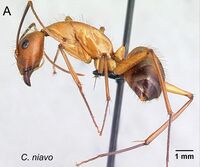Camponotus niavo
| Camponotus niavo | |
|---|---|

| |
| Scientific classification | |
| Kingdom: | Animalia |
| Phylum: | Arthropoda |
| Class: | Insecta |
| Order: | Hymenoptera |
| Family: | Formicidae |
| Subfamily: | Formicinae |
| Tribe: | Camponotini |
| Genus: | Camponotus |
| Subgenus: | Myrmosaga |
| Species: | C. niavo |
| Binomial name | |
| Camponotus niavo Rakotonirina & Fisher, 2022 | |
Camponotus niavo is geographically restricted to the transitional humid forest of Ampasindava Peninsula, the rainforests of the Galoko chain and RS Manongarivo, and the montane rainforest of the PN Montagne d’Ambre. Colony nests are established in rotten logs and rotting tree stumps, while foraging is carried out on the forest floor and through leaf litter.
Identification
Rakotonirina and Fisher (2022) - With head in full-face view, lateral cephalic margin converging posteriorly towards eye level, covered with erect hairs anterior and posterior to eye level; anteromedian margin of clypeus broadly convex; two apical teeth of mandible normally spaced.
See discussion under Camponotus cervicalis for further details.
Keys including this Species
Distribution
Distribution based on Regional Taxon Lists
Malagasy Region: Madagascar (type locality).
Distribution based on AntMaps
Distribution based on AntWeb specimens
Check data from AntWeb
Countries Occupied
| Number of countries occupied by this species based on AntWiki Regional Taxon Lists. In general, fewer countries occupied indicates a narrower range, while more countries indicates a more widespread species. |

|
Estimated Abundance
| Relative abundance based on number of AntMaps records per species (this species within the purple bar). Fewer records (to the left) indicates a less abundant/encountered species while more records (to the right) indicates more abundant/encountered species. |

|
Biology
Castes
Nomenclature
The following information is derived from Barry Bolton's Online Catalogue of the Ants of the World.
- niavo. Camponotus niavo Rakotonirina & Fisher, 2022: 138, figs. 10A, 68 (s.w.) MADAGASCAR.
- Type-material: holotype worker (caste not indicated), 1 paratype major worker.
- Type-locality: holotype Madagascar: Antsiranana, PN Montagne d’Ambre, Antomboka, -12.50035, 49.175, 885 m., 16.xi.2007, BLF18356 (B.L. Fisher, et al.); paratype with same data.
- Type-depository: CASC.
- Distribution: Madagascar.
Unless otherwise noted the text for the remainder of this section is reported from the publication that includes the original description.
Description
Worker
Morphological measurements: see Appendix 1 and Ratios of morphometric data for majors and minors
Minor In full-face view, head sides anterior to level of eye parallel; lateral margins posterior to level of eye converging progressively to posterior margin; length of posterior portion of head behind eye level 1/3 length of head (PoOc/CL: 0.30±0.01; 0.28–0.31). Eyes protruding and large (EL/CS: 0.30±0.02; 0.27–0.33), breaking lateral cephalic margin. Frontal carinae not strongly diverging posteriorly (FR/CS: 0.28±0.01; 0.26–0.30) and posteriorly parallel; clypeus with anterolateral angle and its anterior margin with medial blunt angle or convex. Mandible with six teeth, two apical teeth normally placed. Antennal scape relatively long (SL/CS: 1.55±0.07; 1.40–1.73) with suberect hairs inclined 30°. Promesonotum weakly convex and mesopropodeum feebly convex (MPH/ML: 0.39±0.02; 0.36–0.42), posterior portion of mesonotum flat immediately anterior to metanotal groove, metanotal groove weakly visible, propodeal dorsum anteriorly convex and posteriorly flat, junction of dorsal margin and declivity with blunt angle, propodeal dorsum 2 × as long as the declivity. Petiolar node flattened anteroposteriorly or short and high, its dorsal margin rounding to anterior margin. Tibia of hind leg rounded.
First and second gastral tergites without a pair of white spots. Erect hairs on lateral margin of head anterior to level of eyes present, but absent posterior to level of eyes; posterior margin of head with two pairs of erect hairs; posterodorsal angle of propodeum with a pair of erect hairs.
Major Differing from minor worker in the following characters: enlarged head (CS: 2.92±0.15; 2.62–3.10; CWb/CL: 0.93±0.03; 0.90–0.99), in full-face view with slightly concave posterior margin, eye not breaking lateral cephalic margin; apical 1/4 of antennal scape surpassing posterior cephalic margin; robust mandibles and mesosoma, metanotum distinctly visible; petiolar node tapering dorsally.
Type Material
- Holotype worker. MADAGASCAR: Province Antsiranana: PN Montagne d’Ambre, Antomboka, -12.50035, 49.175, 885 m, montane rainforest, ex rotten log, 16 Nov 2007 (B.L. Fisher et al.) collection code: BLF18356 specimen code: CASENT0134004 (CAS).
- Paratype. 1 major worker of same data as holotype but with specimen code: CASENT0134003 (CAS).
Etymology
The species name niavo is a non-Latin singular noun used in apposition and is derived from the Malagasy word that means “from above”. It refers to the high mountains where the species has been collected.

